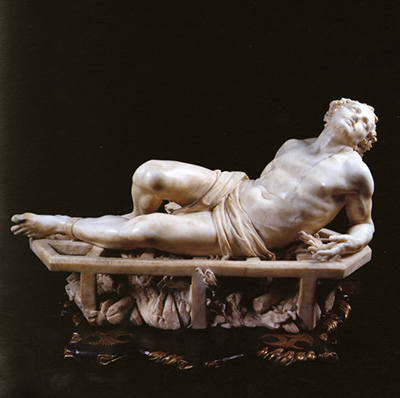The Martyrdom of Saint Lawrence is one of the earliest masterpiece sculptures by Gian Lorenzo Bernini.
The 108 by 66 cm sculpture was carved from a single block of Carrara Marble and dates to approximately 1617, when Bernini was in his late teen years to early twenties. The sculpture currently resides in the Uffizi Gallery, located in Florence, Italy, and is on public display as part of the Contini-Bonacossi Collection. The Italian state acquired the sculpture in 1969, and it has resided in the Uffizi since December 1998.
Details regarding the sculpture's commission are uncertain, as only secondary recounts regarding the sculpture exist. Bernini's biographer, Filippo Baldinucci, recorded that the Martyrdom of Saint Lawrence was created for Leone Strozzi, a Florentine nobleman residing in Rome. Bernini's son, Dominico Bernini, however, recorded that the sculpture was created due to his father's devotion to the Saint and his passion for early Christian martyrs. Regardless of the sculpture's commission, it was acquired by Strozzi and was an article in Strozzi's private collection by 1632.
The subject of Bernini's sculpture is Lawrence of Rome, an early Christian martyr who was sentenced to death by the Roman Emperor Valerian in 258 C.E, as punishment for his adherence to Christianity in defiance of the Roman pagan gods. As was the custom of the Romans, St. Lawrence was forcibly placed upon a gridiron and burnt to death after being tortured. The emotional state of St. Lawrence is the sole focus of the sculpture, as indicated by the lack of secondary figures, such as witnesses or torturers.
The intense emotional state of the Saint is not one of pain, contrary to the initial thoughts of an objective observer, but one of apparent tranquillity. St. Lawrence is depicted as finding salvation in his Christian faith, which has shielded him from the pain and anguish of the physical world. His clear and peaceful eyes are turned toward the sky, along with his body, suggesting a focus on the direction of god, rather than his life.
The lack of pain depicted in the sculpture may also be interpreted as a state of defiance, as St. Lawrence had undeniably thwarted the efforts of the Roman torturers to instil fear into the early Christians by subjecting them to the utmost extent of pain. The reclined position of St. Lawrence combined with his calm demeanour further imputes a state of euphoria, as the Saint knows that his eternal reward is the kingdom of heaven.
The Martyrdom of Saint Lawrence depicts a myriad of features and themes Bernini portrayed throughout his later works, intense emotional states rendered as the sole focus of several masterpieces. Bernini is recognised as being the father of the Baroque style of sculpture, and the Martyrdom of Saint Lawrence was one of the first pieces to initiate this new style.
Restoration work in 1997 revealed the technical excellence of Bernini's talents. Bernini utilised different tools to create different surface textures on various segments of the sculpture, contributing to its' overall aesthetic appeal. Furthermore, the reverse side of the sculpture has not been polished, suggesting that Bernini intended for the sculpture to be viewed from only the front. Gian Lorenzo Bernini was a master of art, far surpassing the rival artists of his time. The Martyrdom of Saint Lawrence is the physical embodiment of Bernini's skill, devotion, talent, and passion, which has inspired innumerable artists and observers worldwide and shall undoubtedly continue to do so.




